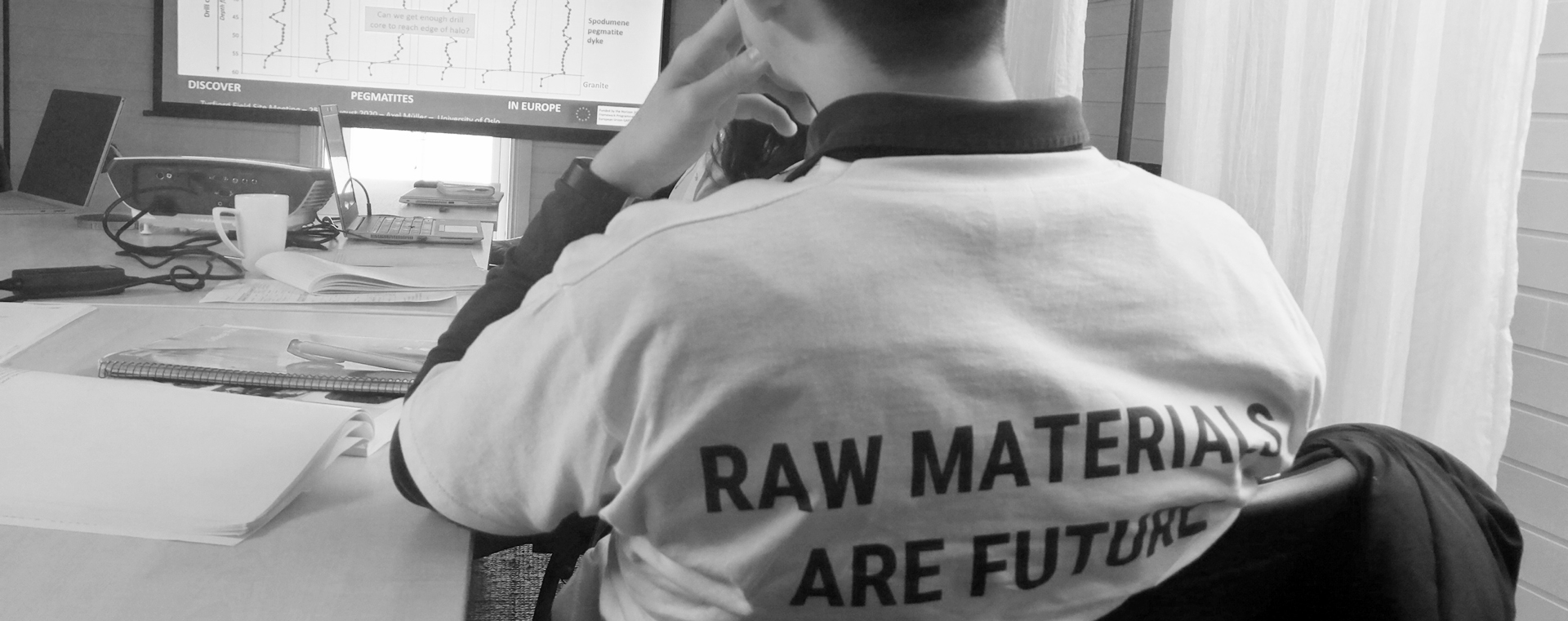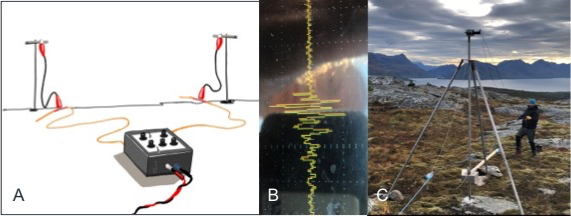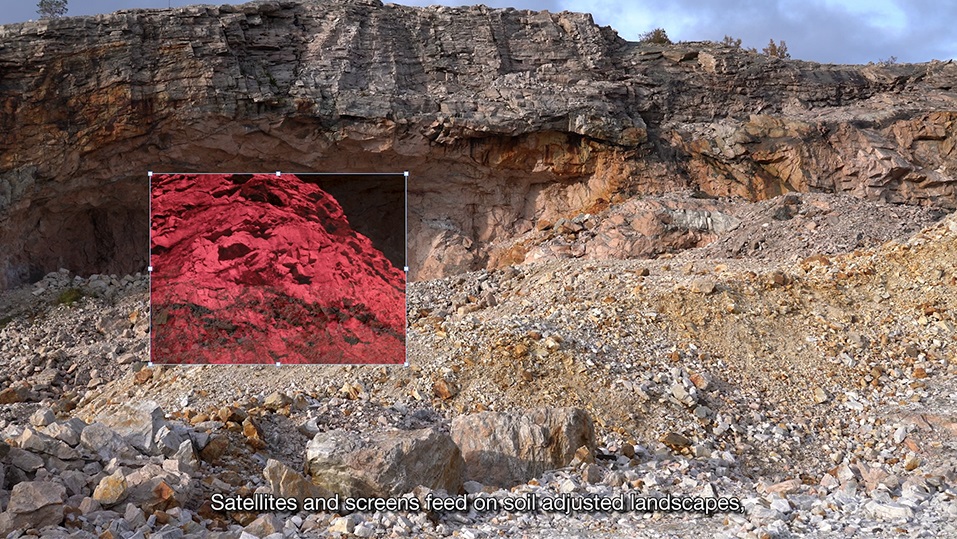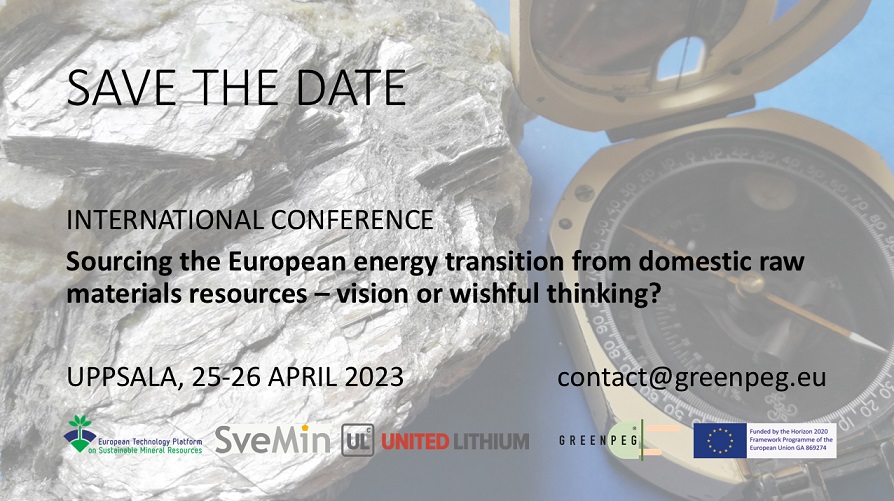

GREENPEG presented the new toolset for exploration of buried pegmatites in three talks and two posters during the EU SuperCluster Lapland Geoconference 30 and 31 October 2023 in Rovaniemi, Finland. The clustering event, organized by the Geological Survey of Finland (GTK) and the University of Queensland, Australia, brought together partners of twelve EU projects and a wide range of stakeholders within the raw materials sector. The toolset was well received by the 140 participants and several stakeholders were interested in the GREENPEG toolset application for lithium exploration in Scandinavian exploration sites. One specific topic of discussions with the stakeholders were the maintenance and further improvement of the toolset after the project ending next year underlining the great interest in the GREENPEG innovations. After the conference the GREENPEG caravan moved on to the 14th Fennoscandian Exploration and Mining conference (FEM) held in Levi, Finland.
As an innovation in the EU-funded H-2020 GREENPEG project (GA 869274), the Geological Survey of Norway (NGU) has developed a state-of-the-art piezoelectric seismograph (PE) as a valuable contribution to pegmatite exploration. The instrument utilizes the piezoelectric effect which describes the conversion of mechanical pressure, such as vibration or strain, into electrical energy, or vice versa. This technology has been leveraged to detect quartz, in particular for gold exploration, since the 1970s. NGU applied newest electrotechnology and data acquisition and processing to customize it for granitic pegmatite exploration. The pilot was deployed in different settings e.g. at the GREENPEG demonstration sites in Tysfjord, Norway, and could successfully detect buried quartz deposits, confirmed by drill cores. In the Tysfjord/Drag pegmatite field, the quartz core of the NYF pegmatite (Niobium-Yttrium-Fluorine) was detected at a depth of 5–10 m and underneath a 1-2 m thick quaternary overburden using minimal invasive explosive charges of ca. 100g. At a second site in Tysfjord/Håkonhals the quartz was found at even 15–25 m depth embedded in the host rocks amphibolite and gneisses, while using an 80 kg drop-weight with minimal environmental impact.

Figure 1. The NGU developed piezoelectric seismograph was deployed at the GREENPEG Tysfjord demonstration site in Håkonhals and Drag. A) shows a sketch of the developed system and B) the recorded and pre-processed signal produced from C) an 80kg drop-weight as seismic source
Since this novel piezoelectric seismograph is exclusively sensitive to the presence of quartz, it has a much lower ambiguity compared to other geophysical methods applied in pegmatite exploration and is a sustainable and cost-efficient method for this type of exploration, both as a stand-alone method or in combination with other methods on brownfields and greenfields.

The conference of the Society of Economic Geologists (SEG), held in London August 26-29 2023 with about 900 participants, addressed the challenges that global exploration and ore deposit research are facing due to accelerated demand and consumption of critical and strategic metals required for the energy transition. The spotlight is on Europe in terms of refined definition of metallogenic domains, development of novel exploration strategies, and re-evaluation of mining potentials. Four GREENPEG partners provided specific solutions how to face the challenges by presenting GREENPEG results including the first public demonstration of the GREENPEG toolset for pegmatite exploration. The feedback and interest in the toolset, which will be published in 2024, was overwhelming underlining the urgent need of improved exploration technologies.

Some partners of the GREENPEG Project Consortium gave support to the media artist Dr Stephen Cornford https://stephencornford.net/ and spent quite some time with him in the field in Tysfjord, Wolfsberg and in Leinster (project demonstration sites) assisting him with questions and guiding him in the field sites. Having visited all three locations, Stephen documented a wide range of the exploration tools and devices used in GREENPEG, recorded some typical scenes of people doing geophysical work and took videos from stills and made sound records such as the internal clicking and beeping of some of the devices. More information will be given in our September issue of GREENPEG Newsletter. See also the video which is now online available for streaming here:
https://avantwhatever.xyz/w/tsSQUPENFwnYfwJTche3jh
Artist Biography
Stephen Cornford is a media artist who works with consumer electronics, critiquing the ideologies they embody and the constitutive role they have come to play in our lives. His current research is concerned with the toxicity of digital media, the complex metallurgy of ubiquitous technologies and relationships between planetary and photographic space.
Much of his recent work has been made in collaboration with scienctific researchers. He has worked alongside commercial geophysicists prospecting for technology metals in Europe and volcanologists studying magma crystallisation with X-rays. His practice often employs laboratory processes or scientific imaging, using geological furnaces to transform electronic waste or optoelectronics facilities to damage cameras.

Sourcing the European energy transition from domestic resources – vision or wishful thinking? This one-day conference questions Europe's raw materials supply security in the context of its economically viable raw material potential and of current geopolitics. It examines the existing and future framework conditions for mining projects and their downstream value chain (regulation, financing, permitting). The question arises, which course do we follow?
The conference also focuses on the work of the European Geological Surveys for the territorial mapping of critical raw materials and highlights the potential for cooperation with Africa. On April 26th, a site visit is offered by United Lithium Corp. to Bergby Lake Lithium exploration project.
Sweden currently holds the EU Council Presidency for the first half of 2023. Sweden is one of the most important mining countries in Europe with great raw material potential for managing the energy and mobility transition and securing the raw material supply for future technologies.
The conference is hosted by the EU HORIZON 2020 project GREENPEG, in cooperation with the Swedish Mining Association SVEMIN and the European Technology Platform on Sustainable Mineral Resources (ETP SMR) and will take place in picturesque city of Uppsala, 20 minutes by train from Stockholm Airport. Participation is free of charge.
| Registration now open – Program and Logistics |  Follow via Linkedin Follow via Linkedin |

Including the world-class spodumene pegmatites at Manono-Kitotolo presented by Prof Anouk Borst, KU Leuven. She will discuss the geology, as well as some socio-economic and political aspects of exploration and mining in DRC, in the context of widespread artisanal mining and conflict. Get familiar with this topic also by DER SPIEGEL International Article “China Battles West for Raw Material of the Future”. Do you wish to join GREENPEG SIMS? Subscribe by contacting us: contact@greenpeg.eu
The two-week-long Summer School in Tysfjord, Norway aims to give students strong practical insight into exploration for pegmatites, one of the most popular exploration targets in Europe now and in years to come. The Summer School will help students to familiarise themselves with the latest ground and airborne exploration technologies that meet the highest social and technical standards. Students will understand the economic aspects of mine development with a focus on exploration and investors´ approach in financing mining projects.
There is no participation fee and GREENPEG will cover accommodation and traveling costs. More information can be found in the promotional flyer and the application package. If you have any further questions, please do not hesitate to contact Mrs. Meng-Chun Lee (mengchun.lee@gkz-ev.de) from GKZ Freiberg for assistance.
GREENPEG partner NGU recently released a movie introducing into the developing of a cutting-edge piezoelectric instrument. While pegmatites are commonly thought to be relatively invisible to geophysical exploration methods, this approach addresses the susceptibility of, in particular, quartz pegmatites to respond to seismic deformation with an induced electric signal- the piezoelectric effect. The interpretation of the captured electric signal can aid in identifying and locating potentially buried pegmatite ores. The instrument's effectiveness and ability to play a significant role in the GREENPEG toolkit have been thoroughly tested with diverse seismic sources in varied geological environments. We are currently interpreting the data and refining the data acquisition process.
Sourcing the European energy transition from domestic resources – vision or wishful thinking? The one-day conference (April 25) questions Europe's raw materials supply security in the context of its economically valorizable raw material potential and of current geopolitics. It examines the existing and future framework conditions for mining projects and their downstream value chain (regulation, financing, permitting). The conference also focuses on the work of the European geological surveys for the territorial mapping of critical raw materials and highlights the potential for cooperation with Africa. On April 26th a site visit is offered to Bergby exploration project of United Lithium Ltd. In 2023 Sweden is taking over the EU Council Presidency. Sweden is one of the most important mining countries in Europe with great raw material potential for managing the energy and mobility transition and securing the raw material supply for future technologies. The conference is co-hosted by GREENPEG, the Swedish Mining Association SVEMIN and the European Technology Platform on Sustainable Mineral Resources (ETPSMR) and will take place in picturesque city of Uppsala, 20 minutes by train from Stockholm Airport. Participation is free of charge.
GREENPEG partners have been invited by Lithium Americas Corp. to verify individual methods of the GREENPEG toolset at their exploration sites in Ontario, Canada. Of particular interest for both sites is to test the new method of the regional trace-element-in-quartz mapping to establish the province-scale chemical zoning of the Allison Lake pegmatite field to vector towards areas with lithium-mineralized pegmatites and to establish the genetic relationship to the nearby Allison Lake Batholith. The field campaign will follow the joint annual meeting of the Geological Association of Canada, Mineralogical Association of Canada, and Society for Geology Applied to Mineral Deposits held in Sudbury, Ontario, May 24-27, 2023, in which several GREENPEG partners will participate. In the frame of the conference, GREENPEG is organizing the session “Lithium in Pegmatites: Mineralogy, Petrogenesis and Classic to Innovative Exploration Techniques” together with Tania Martins from the Manitoba Geological Survey and Lee Groat from the University of British Columbia.
EVENTS – MEET GREENPEG!
The one-day conference on 14th of Mai 2024 aims at introducing GREEPEG research results to potential end-users and strengthening Europe’s strategic raw materials partnership with Namibia. The program focuses on advances in the exploration of pegmatites by research and experiences from past and ongoing pegmatite exploration and mining throughout Africa. The conference provides floor for contributions from the public and private surveying and exploration followed by a B2B session and networking.
Over 15th and 16th of May 2024 we offer a guided site visit to the famous Erongo Mountain pegmatite outcrops and exploration activities including one overnight stay in an African-style lodge. The conference is hosted by the EU HORIZON 2020 project GREENPEG, in cooperation with the Geological Survey of Namibia, the Federal Institute for Geosciences and Natural Resources, Germany, and Gecko Exploration, Namibia.
Find Programme here. The Call for Speakers is open until 30 April 2024.
Contact us! Email: contact@greenpeg.eu
The workshop will bring together relevant stakeholders at industry level and representatives of neighboring EU projects to explore and discuss the latest achievements made towards the demonstration of an innovative, competitive toolset for the exploration of buried LCT and NYF pegmatites, including three new instrumental techniques and devices: piezoelectric sensor, helicopter-complementary nose stinger magnetometer, drone-borne hyperspectral imaging system, and two new datasets for prospect scale (<50 km²) and district scale (50-500 km²) exploration. The Workshop will take place at the Auditorium 003, FC5, Faculty of Sciences, University of Porto, Portugalx Address: Edifício dos Serviços Centrais FC5, piso 0, Rua do Campo Alegre, s/n, 4169-007 Porto.
Find the Programme HERE.
GREENPEG will be presented by a number of partners at the PDAC convention trade show, check out at the:
- EU booth introducing into EU R&I projects in the field of #RawMaterials. Don't miss the #workshop "R&I for mineral exploration and extraction in the EU" on 5 March, 14.00-16.00 Booth 931, South Building, Metro Toronto Convention Centre (MTCC), GREENPEG Coordinator Axel Müller will present GREENPEG at 15:10-15:20.
- German Pavilion at terratec Geophysical Services booth in 6108N-6 North Building
- Geological Survey of Norway (NGU) booth in the Metro Toronto Convention Centre (MTCC).
NOVEMBER 13-17 2023, BRUSSELS, BELGIUM – EU RAW MATERIALS WEEK
GREENPEG project presentation on 13 November 14:15 – 14:30 by Claudia Haase, NGU
OCTOBER 31 UNTIL NOVEMBER 3 2023, LEVI, FINLAND – 14th FENNOSCANDIAN EXPLORATION AND MINING
GREENPEG will be at the tradeshow introducing GREENPEG Nose Stinger and GREENPEG Toolset CONTACT US
OCTOBER 30-31 2023, ROVANIEMI, FINLAND - EU SUPERCLUSTER LAPLAND GEOCONFERENCE
GREENPEG will be presented with 3 oral and 2 poster presentations introducing into the GREENPEG toolset, geophysical exploration advances in NYF-type pegmatite deposits in Tysfjord, Norway. CONTACT US